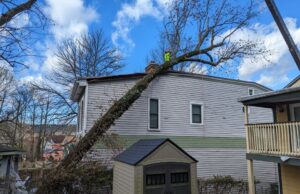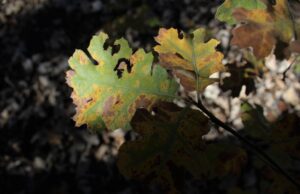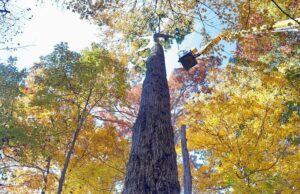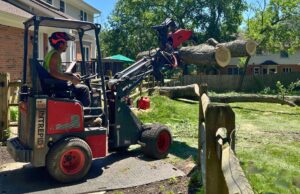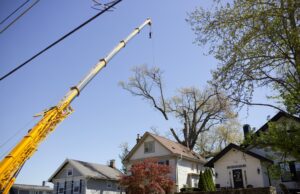As spring arrives, it can be difficult to tell if your tree is dead or if it’s just still dormant. You expect your tree to grow leaves again in spring, but what if it doesn’t?
If you’ve noticed trees around the neighborhood budding while yours are barren, don’t panic! Just because spring is in full swing doesn’t mean your specific trees are ready to bloom or leaf out.
The key is to understand the difference between a tree that has died and one that’s just late to break dormancy. There are many reasons why a tree will leaf out later than others, ranging from tree species to microclimates, location, sunlight exposure, and canopy coverage.
Is the Tree Dead or Dormant?
To determine if your tree has survived winter in Cincinnati, try these four simple tests that can tell you if your tree is still dormant or if it’s dead.

1. Inspect the Tree Trunk and Bark
Examine the color and texture of the bark. If it looks different from nearby trees of the same species or if a branch looks different from the rest of the tree, it may be a sign of a dead branch or tree.
Signs of excessive decay, such as peeling bark, gaping wounds, or fungal growths, can indicate that the tree is in decline or even dead.
2. Bend the Twigs
If you’re inspecting a smaller tree, the branches can tell you a lot about the tree’s condition.
Grasp a small branch or twig and try to bend it. If it snaps easily and the interior looks dry and brittle, that’s not a good sign. In a healthy tree, the wood should bend instead of snapping in two (although if you bend it too far, any branch will eventually break). It’s important to keep in mind though, that this isn’t true for every branch on every tree.
A single twig or small branch breaking means you have one or more dead branches, though the rest of your tree can be healthy. Test multiple branches to determine if there’s a problem impacting more than one area of your tree before making a decision about the status of the entire tree.
3. Look for New Buds
Even in the dead of winter, dormant trees still have buds on the ends of branches. As spring arrives, these buds begin to swell (although they may still be very small and can be difficult to see early in the season). Take your time checking for new buds forming on the branches of your tree.
Swelling buds, especially if they’re starting to turn green, are a good sign, but you may not find them on every branch. It’s not uncommon to find some branches with new buds while others have no buds in sight. Be patient; if the branches are flexible, the bark looks normal, and they pass the “scratch test”, they could just be a little behind in breaking dormancy.
And even if you find one or more dead branches, it isn’t a death sentence for your tree – just prune out the deadwood once you’re sure it’s truly dead.
4. Try the “Scratch Test”
Cambium is the green, growing layer inside a tree’s trunk and branches. It is responsible for producing new bark and wood.
Peel back a little bit of bark on one or more small stems or twigs. On trees and shrubs with thinner bark, use a fingernail to gently scratch the surface layer away. For thicker bark, use pruning shears or a knife to scrape at the surface. You’re trying to get to the cambium layer directly below the outer bark so don’t cut into the branch; just scrape away the surface.
If you find a wet, green layer underneath the bark, that’s cambium and a sign that your tree is in good health.
Even dormant trees still have live cambium so if you find nothing but grey, extremely dry wood beneath the outer bark, it’s probably a sign that the branch is dead and may need to be cut off.

The Eastern redbud is one of the earliest trees to bloom, giving a bright pink splash of color to Cincinnati’s early spring landscape.
It’s Normal for Some Tree Species to Leaf Out Earlier Than Others
“Leafing out” refers to the time when your tree produces leaves in the spring. Homeowners sometimes worry about certain trees in their yard that are still bare while others have already begun to leaf out.
In Cincinnati, you’ll find a blend of many tree types. For example, we have plenty of oak and elm trees in the area, both of which leaf out later in spring than other tree types to protect against sudden drops in early spring temperatures. We also have sugar maples, birch, and willow trees in Greater Cincinnati, which begin to show buds as early as April to lengthen their pre-summer food production time. And then there’s the Eastern redbud (Cercis canadensis) which starts blooming even earlier in spring, producing brilliant clusters of purple-pink flowers.
Each species has its own schedule for leafing out so don’t worry unless all surrounding trees of the same species are in full leaf but yours isn’t.
Not All Trees Emerge from Dormancy at the Same Time
Trees decide to leaf out based on a combination of springtime signals including warmer weather, longer days with increased sunlight, elevated soil temperature, and the availability of nutrients and water. These factors trigger an internal change in trees, prompting them to grow new leaves and take advantage of favorable growing conditions.
However, not all trees respond to these cues in the same way or at the same time. The timing of leaf out in trees is influenced by many other factors, such as:
- Sunlight Exposure: Trees that receive more sunlight may leaf out faster than those in shaded areas.
- Tree Species: Different tree species have varying leaf-out times based on their genetic makeup and adaptation to the local climate.
- Individual Tree Health: Healthier trees with optimal conditions may leaf out earlier compared to stressed or unhealthy trees.
- Location and Microclimates: Trees respond to local factors and microclimates, such as south-facing slopes receiving more direct sun, which can create variations in the timing of leafing out among different tree species.
Your Neighborhood’s Trees May Just Leaf Out Later
Trees may leaf out later in spring in some areas of Cincinnati compared to others due to factors like tree canopy coverage, microclimates, sunlight exposure, and local environmental conditions.
The unequal distribution of tree canopy in Greater Cincinnati, with some areas having less than 24% tree canopy and others nearly 100%, influences the timing of leaf emergence in spring. Areas with more trees, such as Mount Airy and Westwood, may experience earlier leaf-out due to better environmental conditions and ecosystem services provided by trees. In contrast, neighborhoods with lower tree canopy coverage, like Oakley and Pendleton, may see delayed leaf emergence.
Different areas within Cincinnati may also have varying levels of sunlight, temperature, and soil moisture, influencing the timing of springtime leaf emergence in trees. For instance, south-facing slopes receiving more direct sunlight may experience earlier leaf-out compared to shaded areas. Variations in soil conditions and moisture levels can also impact the rate at which trees leaf out in different parts of the city.
Organizations like the Cincinnati Parks Foundation and the Cincinnati Urban Forestry Program monitor when trees around the city start to produce leaves in spring. This information helps in assessing the health and vitality of the urban forest, identifying any potential issues or changes in tree behavior, and guiding urban forestry management practices.
Don’t Panic Yet – Wait Until Summer Arrives
If you suspect that your tree may not have survived Cincinnati’s winter, it’s best to wait until early summer before taking action. By this time, if your tree hasn’t started putting out leaves, it’s an indication that the tree is likely dead rather than dormant.
Not Sure If Your Tree is Just a Late Bloomer?
After inspecting your trees, if you’re not completely certain whether they’re dead or dormant, call the arborists at Lefke Tree Experts for help. Although we suggest waiting until early summer to assess the tree’s condition, our experienced arborists are able to identify deadwood at any time of year. Knowing if your tree is dead or alive will help you make informed decisions about potential actions like removal or replacement.
Simply fill out a request form or give us a call today at 513-914-6041 to put Cincinnati’s tree experts on the case!

